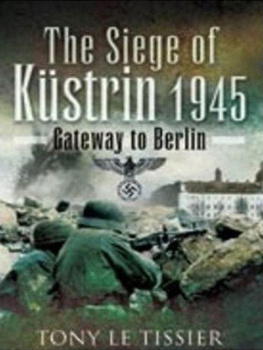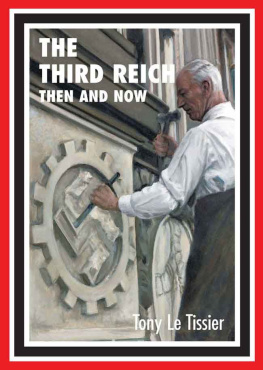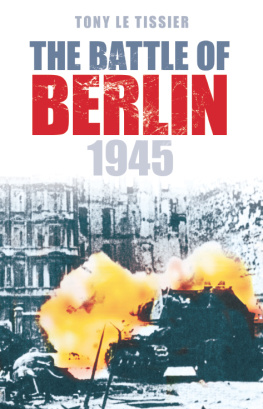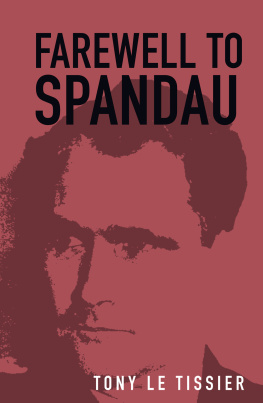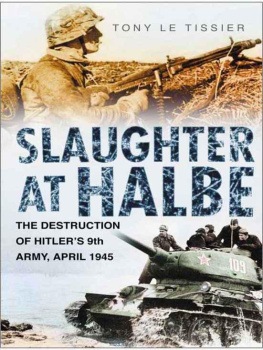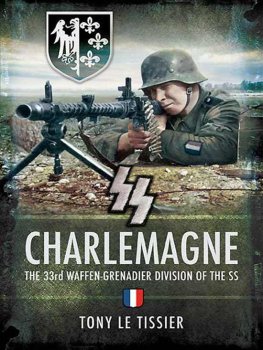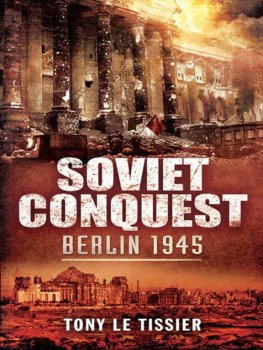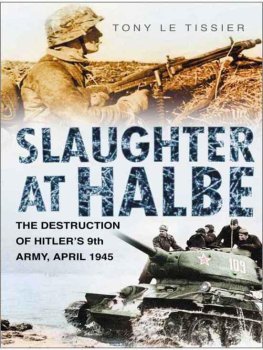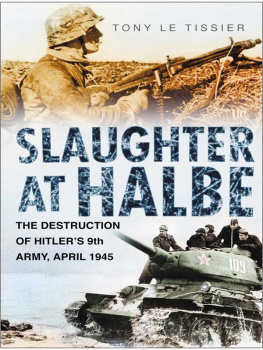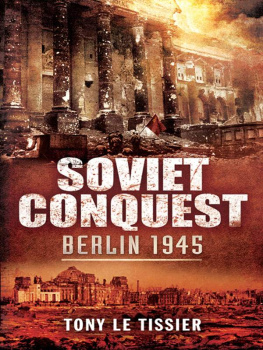RACE FOR THE
REICHSTAG
RACE FOR THE
REICHSTAG
THE 1945 BATTLE FOR BERLIN
by
TONY LE TISSIER
First published by Frank Cass Publishers
in the U.K. in 1999
Republished in this format in 2010 by
Pen & Sword Military
An imprint of
Pen & Sword Books Ltd
47 Church Street
Barnsley
South Yorkshire
S70 2AS
Copyright Tony Le Tissier, 1999, 2010
ISBN 978 1 84484 230 4
The right of Tony Le Tissier to be identified as Author of this work has been
asserted by him in accordance with the Copyright, Designs and Patents Act 1988.
A CIP catalogue record for this book is
available from the British Library
All rights reserved. No part of this book may be reproduced or transmitted in any
form or by any means, electronic or mechanical including photocopying, recording
or by any information storage and retrieval system, without permission from the
Publisher in writing.
Printed and bound in England
By CPI
Pen & Sword Books Ltd incorporates the Imprints of Pen & Sword Aviation,
Pen & Sword Family History, Pen & Sword Maritime, Pen & Sword Military,
Wharncliffe Local History,
Pen & Sword Select, Pen & Sword Military Classics, Leo Cooper,
Remember When, Seaforth Publishing and Frontline Publishing
For a complete list of Pen & Sword titles please contact
PEN & SWORD BOOKS LIMITED
47 Church Street, Barnsley, South Yorkshire, S70 2AS, England
E-mail: enquiries@pen-and-sword.co.uk
Website: www.pen-and-sword.co.uk
CONTENTS
Between pages 106 and 107
For the Red Army, the Battle for Berlin was the final battle in a long and tortuous struggle for victory in mankinds most devastating war. For the German Wehrmacht, the Battle of Berlin represented the final desperate attempt to preserve the existence of Adolf Hitlers putative thousand-year Third Reich. Momentous as the battle was for both sides, the ferocity with which it was fought still defies the imagination, since its outcome and the outcome of the war as a whole was no longer in doubt. During over four years of war, the pendulum of success had swung wildly between Germany and the Soviet Union. In summer 1941, and again in summer 1942, German fortunes soared as its armies drove inexorably forward, first towards Leningrad and Moscow, and then to the banks of the distant Don and Volga Rivers. In turn, Soviet fortunes rose each winter as the Red Army won equally unprecedented victories at Moscow and Stalingrad. During the climactic Battle of Kursk in summer 1943, the tide finally turned decisively in the Soviets favour. Thereafter, the Red Army embarked on a nearly continuous march to victory against an increasingly exhausted and threadbare Wehrmacht. By early April 1945 the scarred armies of the two antagonists faced one another along the banks of the Oder River, only 40 kilometres from Berlin. By then, Soviet victory was but one battle away and there was no doubt over which army would emerge supreme. Nonetheless, memories, reputations and simple pride on the one side, and a stoic determination to atone for 29 million casualties and years of immeasurable suffering on the other, made the ensuing Battle for Berlin one of the fiercest and most costly battles of the war.
In this, his third, book on the Battle for Berlin, Tony Le Tissier focuses on the final battle for the Reichstag, the seat and virtual symbol of German power. Exploiting a wide range of Soviet sources and unprecedented German archival and memoir materials, the author has created a detailed and touchingly human mosaic out of the immensely complex, agonizing and almost ceremonial struggle for the final hundreds of metres of soil under Wehrmacht control. The result is a fitting memorial to the soldiers who were sacrificed in the name of victory or their Fhrer during the final battle of this most terrible war.
David M. Glantz
Carlisle, Pennsylvania
March, 1999
This account of the battle for Berlin was originally compiled some 30 years ago from the source material then available as an attempt to produce a definitive account of the battle for the city of Berlin. It took another ten years before an encounter with the author Len Deighton opened the way to publication. Subsequent historical events opening up access to places, people and information hitherto denied me, and this, together with feedback from the later German editions, have enabled an extensive revision of the original work, which I described as being rather like the reconstruction of an ancient vase from an incomplete set of fragments.
I believe that my original edition was the first publication to draw attention to the extent and consequences of the bitter rivalry between Marshals Zhukov and Koniev that Stalin was so skilfully manipulating from Moscow. The veil is now lifted on further aspects of this battle hitherto masked by decades of Soviet propaganda.
To assist the reader through the complexities of this operation, I have endeavoured to illustrate the various parts and phases with a series of maps and drawings, incorporating as many of the place-names mentioned in the text as were feasible. Where place-names have been changed, the new version is given in brackets after the old. Reference to the maps on which these names appear has been included in the index. I have also used breaks in the text to indicate switching between the narration of German and Soviet aspects and between those of the rival marshals.
For those who would like to explore the battlefield, I recommend my Berlin Battlefield Guide Third Reich and Cold War.
The original work upon which this book is based would not have been possible without the active encouragement and assistance of many people, among them Tom Bonas, Michael Craster, Professor Christopher Donnelly, David Dunkelly, the late David Forrer, Dr Jrgen Freymuth, Professor Dr Werner Knopp of the Stiftung Preussischer Kulturbesitz in Berlin, Otto Spitz of the Berlin Verlag and Oberstleutnant Dr Rohde of the Militrgeschichtliches Forschungsamt in Freiburg.
I also wish to thank the many people who have helped me with my further research in producing this greatly revised text, including Horst Denkinger, Oberst a.D. Theodor von Dufving, Professor Dr Walter Kroemer, Lothar Loewe, the late Willi Rogmann, Oberst a.D. Skorning, Lennart Westberg of Sundsvall, Sweden, Horst Wilke and Oberst a.D. Horst Zobel.
I am especially grateful to Dorothe Freifrau von Hammerstein-Equord for all her invaluable assistance over the years.
For much of the material on which the maps are based I am indebted to the friendly co-operation of the staffs of the Institut fr Geodsie; Department V of the Senator fr Bau- und Wohnungswesen; the Landesarchiv; the Landesbildstelle and Firma Rhll all in Berlin the Air Photo Library of the University of Keele; the Royal Air Force Museum, Hendon; and the former Soviet Army Museum, Karlshorst.
Thanks are also due to the staffs of the former 38 Regional Library, Royal Army Education Corps; the former US Army Nicholson Memorial (previously Crump Hall) Library; the Staatsbibliothek and Amerika-Gedenk-Bibliothek in Berlin; and the Imperial War Museum in London.
I am also grateful to Colonel (ER) Pierre Rocolle for his kind permission to allow me to include translations of French eyewitness statements taken from his Gtterdmmerung La Prise de Berlin; to Helmuth Altner for permission to quote the Oranienburg Hitlerjugend story from his Totentanz Berlin; to the Chief of the Military History Office, HQ USAREUR, for permission to include quotations from Wilhelm Willemers
Next page

